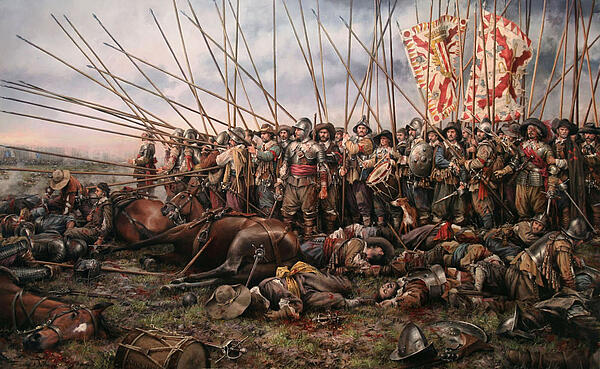Thirty Years War
The Thirty Years War was a series of wars in Central Europe from 1618-1648. It started as a conflict between Protestant and Catholic states following the fragmenting of the Holy Roman Empire, but it turned into a more general conflict involving most of the great powers of Europe, becoming a war for European political pre-eminence.
The Thirty Years' War caused the destruction of entire regions and triggered a famine, which significantly decreased the population of the German and Italian states, the Low Countries and the Kingdom of Bohemia.

What were the causes of the Thirty Years War?
The Thirty Year’s Year was primarily a struggle over the political and religious order within Europe. It was a result of a number of factors, some of which had built up over many years. These included religious antagonisms and power struggles.
Religion
The Peace of Augsburg signed in 1555, brought peace to Europe but it did not settle the religious disagreements in Germany. The settlement recognised only Lutherans and Roman Catholics, but Calvinism had subsequently made gains in a number of states. The Calvinists began to demand recognition of their rights.
This emergence of three Christian groups - Cavinists, Lutherans and Catholics - meant that each one was tousling for power within Germany. Catholics launched the Counter-Revolution to regain lost power, but this encouraged Calvinists and Lutherans to work harder to attract followers. Followers of all three religions were at times successful, but only at the expense of the others.
Rising religious tensions caused rulers to monitor the conduct of their subjects more closer and severely punish those who converted. As tensions rose, so did paranoia, until religion controversy became so obstructive that at times it stood in the way of trade and governance.
The Defenestration of Prague is an example of the conflict between religious groups. In 1617, the Bohemian Diet elected Ferdinand of Styria as king of Bohemia. Ferdinand, a member of the Hapsburg family, became Holy Roman emperor two years later. He was an ardent supporter of the Catholic cause.
Ferdinand's election alarmed Bohemian Calvinists, who feared the loss of their religious rights. In May 1618, the Calvinist revolt began when the rebels threw two Catholic members of the Bohemian royal council from a window some seventy feet above the ground. Both councillors fell into a pile of manure, and suffered only minor injuries. This incident became known as the Defenestration of Prague.
The Bohemian Revolt
This incident was a signal for the beginning of a Bohemian revolt against the Habsburg emperor Ferdinand II. This marked the opening phases of the Thirty Years’ War and saw the Bohemian Estates rise up against the rule of the Habsburg dynasty.
To quell the rebellion, Ferdinand enlisted the help of his German states. However, only the states that were loyal to Catholicism joined the fight. The Holy Roman Empire and the Catholic states invaded Bohemia and quashed the rebellion. The dispute climaxed after several battles in the final Battle of White Mountain, where the estates suffered a decisive defeat. With this, the Bohemian phase of the Thirty Years War ended in a victory for Catholicism and the Habsburgs of the Holy Roman Empire.
After the Bohemian phase came the Danish phase, which saw Christian IV of Denmark - a Protestant king - declare war against the Empire in 1625. The German states loyal to Protestantism joined Denmark while France gave the country its financial backing, despite being a Catholic country. This is when it becomes clear that the Thirty Years War was not simply a battle between Protestantism and Catholicism - France disliked the Habsburg Dynasty and would do anything to curb its power. So its motivation was political rather than religious.
With the support of German Protestants and France, the Danish Protestants initially enjoyed some victories. But in the end, the Habsburgs swept through Germany and handed the Protestants yet another defeat. This ended the Danish phase of the war.
By this stage, Protestants across Europe feared the Habsburg victories. Sweden responded by moving into Germany in 1630, aided by the remaining German Protestants. Again, France gave its financial backing to Sweden. The Swedish Protestants, led by Gustavus Adolphus, won several notable victories. However, when Adolphus was killed in battle the Holy Roman Empire was able to make up for lost ground, defeating the Swedes in southern Germany.
The Peace of Prague brought the Swedish phase to an end in 1635. The Treaty effectively brought to an end the civil war aspect of the Thirty Years' War. However, the combat still carried on due to Spain, Sweden and France’s intervention.
France shattered the settlement reached in the Treaty of Prague when it decided to intervene. The chief minister of France, Cardinal Richelieu wanted to weaken the Habsburg power and capture the province of Alsace. Each side had their moment of glory, but in the end France’s victory over Spain allowed the French to send larger forces into Germany, tipping the balance in their favour.
The Peace of Westphalia of 1648 ended the Thirty Years' War. Sweden was given western Pomerania, Eastern Pomerania took Brandenburg and France annexed part of Alsace.
The settlement formally recognised the independence of Switzerland and the Dutch Republic and granted the German states the right to make alliances and treaties. To settle religious disputes, the Peace of Westphalia expanded the Peace of Augsburg to include Calvinists.
Although the Thirty Years War began with a rebellion, it grew into such a large-scale conflict as a result of the religious and political tensions in Europe. The Bohemian revolt effectively ignited a powder keg of unrest - resulting in one of the most devastating power struggles in history.
MLA Citation/Reference
"Thirty Years War". HistoryLearning.com. 2024. Web.
